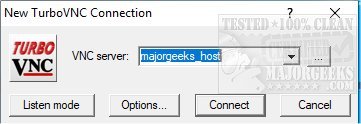TurboVNC is a high-performance, enterprise-quality version of VNC for Windows and Linux based on TightVNC, TigerVNC, and X.org that allows efficient VNC server connections.
TurboVNC is a high-performance, enterprise-quality version of VNC for Windows and Linux based on TightVNC, TigerVNC, and X.org that allows efficient VNC server connections.
It contains a Tight encoding variant for maximum performance and compression with 3D applications (VirtualGL), video, and other image-intensive workloads. TurboVNC, in combination with VirtualGL, provides a complete solution for remotely displaying 3D applications with interactive performance. TigerVNC and libvncserver have adopted TurboVNC's high-speed encoding methods, and TurboVNC is also compatible with any other TightVNC derivative.
TurboVNC forked from TightVNC in 2004 and still covers all of the TightVNC 1.3.x features, but TurboVNC contains numerous feature enhancements and bug fixes relative to TightVNC. It compresses 3D and video workloads much better than TightVNC while generally using only 5-20% of the latter's CPU time. Using non-default settings, TurboVNC can also be made to compress 2D workloads as "tightly" as TightVNC.
On "modern" hardware, TurboVNC is capable of streaming 50+ Megapixels/second over a 100 Megabit/second local area network with perceptually lossless image quality. TurboVNC can stream between 10 and 12 Megapixels/second over a 5 Megabit/second broadband connection at reduced (but usable) image quality.
TurboVNC Features:
Fine-grained control over the JPEG image quality and level of chrominance subsampling
Double buffering on the client-side to reduce tearing artifacts in 3D and video applications
Flexible and configurable full-screen/multi-screen support
Full support for IPv6
Advanced flow control and continuous updates (greatly improves performance on high-latency connections)
Authentication with one-time passwords or Unix login credentials (in addition to standard VNC passwords)
Access control lists (for sharing VNC sessions with only certain users)
Allows security/authentication policies to be set globally for a particular server machine
Multithreaded encoding
“Lossless refresh” allows a viewer to request a lossless copy of the current screen image, either manually or automatically (after a specified number of seconds of inactivity)
High-performance zero-install Java viewer, deployable using Java Web Start, that calls libjpeg-turbo through JNI to achieve native levels of performance
Similar:
How to Add 'Allow Sleep with Remote Opens' Power Setting
Download


